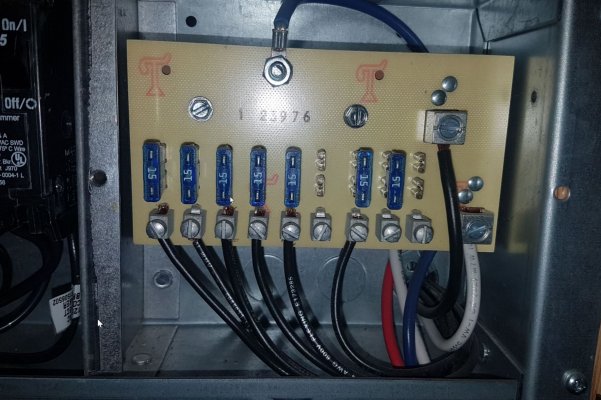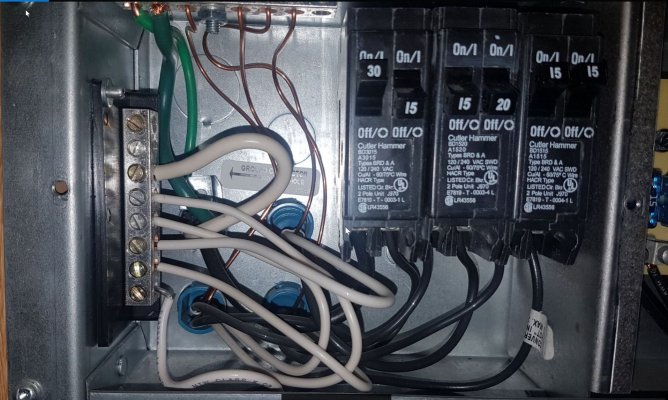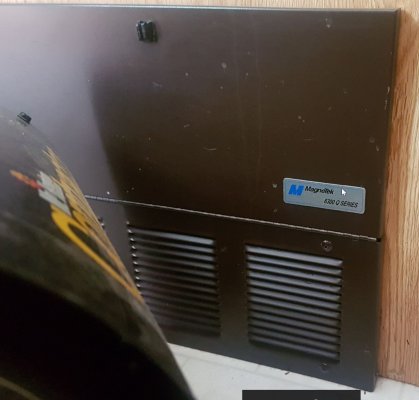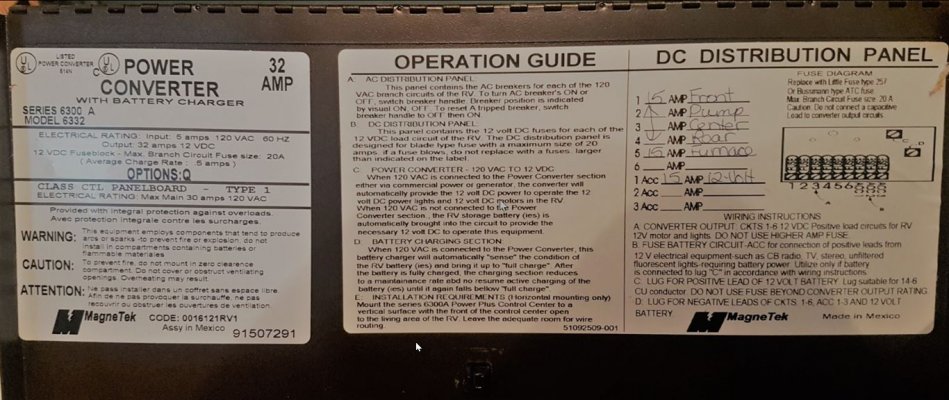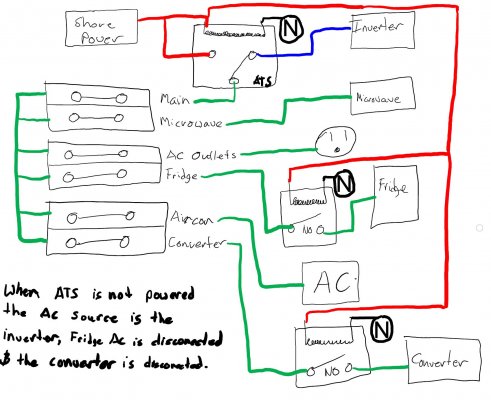I really hope I am not missing this information somewhere else, because I tried to find it and had no luck.
I have a Magnetek 6300 Q series converter. But there is no aux AC in.
So, My goal is:
-AC Power from an 3000w inverter
-Do not try and charge my batteries via the inverter
-Do not Run the fridge from the inverter (That's what propane is for )
)
-Does give me 12vDC from the batteries for lights and what not.
-Does allow me to use shore power in the same way I do before making any changes.
-ALL OF THIS MUST BE AUTOMATIC, so I don't mess it up.
This configuration when unplugged from shore power puts the inverter as the AC source, disables AC on the Fridge and disconnects the Converter from the AC circuit (preventing it from trying to charge the batteries).
In the attached drawing you will see a SPDT relay at the top and the converter on a Normally Open relay for the converter. This is done with a single 120vAC coil relay. (Search this on ebay or amazon PBC-RE-GP-DPDT-120VAC) I actually used this DPDT relay because it allowed me to switch the converter and the AC source with one high amperage relay. Then I switch the fridge with an 10amp 120vAC relay.
Doing this means I do not need to replace the entire converter. I am basically leaving it intact. This is nice because I want to keep the breakers on the AC side, and fuses on the 12vDC side. I don't want to have to do major surgery. I am kinda broke after buying the trailer lol.
Just to clarify some terms:
DPDT = One relay, that behaves like two switches, Both switches have a Normally open and normally closed positions
SPDT = One relay, that behaves like one switch, that switch has a Normally open and normally closed positions
NO = Normally Open
NC = Normally Closed
AC = Alternating Current NOT Air Conditioning
N = The N in the drawing is Nutral. All relays are AC relays.
oh, and: The drawing is crappy, but I think it could help. I have 6 breakers in my panel. 3 sets of two.
The colors of the wire in the drawing is just to keep things clear, NOT actually representations of the correct colors.
BE CAREFUL!!! Make sure your wire / Relays / and all parts are rated for the kind of current you are pulling. My converter is a 30amp and my main breaker is a 30amp, this is why I used a 30amp DPDT relay, my fridge pulls 8amps at 110vAC so I used a 10amp (30amp inrush) to give some wiggle room. All my wire is much heavier than the crappy 18awg wire that I found in this trailer. Try to NEVER make changes before the breaker (AC Source side) if you can avoid it. Keep the breakers or fuses in a safe place to protect you from making mistakes. This DIY project, is not a good first AC project. You have to sleep here, you dont want to die here....
I really hope this drawing helps someone. It would have saved me a lot of time tracing wires in my system. But keep in mind, all RV power systems are different. Ask your RV dealer if your converter supports an AUX AC source. You may have all this work already done for you. DO NOT DO A MESSY JOB, you WILL have to troubleshoot it in the future.
I have a Magnetek 6300 Q series converter. But there is no aux AC in.
So, My goal is:
-AC Power from an 3000w inverter
-Do not try and charge my batteries via the inverter
-Do not Run the fridge from the inverter (That's what propane is for
-Does give me 12vDC from the batteries for lights and what not.
-Does allow me to use shore power in the same way I do before making any changes.
-ALL OF THIS MUST BE AUTOMATIC, so I don't mess it up.
This configuration when unplugged from shore power puts the inverter as the AC source, disables AC on the Fridge and disconnects the Converter from the AC circuit (preventing it from trying to charge the batteries).
In the attached drawing you will see a SPDT relay at the top and the converter on a Normally Open relay for the converter. This is done with a single 120vAC coil relay. (Search this on ebay or amazon PBC-RE-GP-DPDT-120VAC) I actually used this DPDT relay because it allowed me to switch the converter and the AC source with one high amperage relay. Then I switch the fridge with an 10amp 120vAC relay.
Doing this means I do not need to replace the entire converter. I am basically leaving it intact. This is nice because I want to keep the breakers on the AC side, and fuses on the 12vDC side. I don't want to have to do major surgery. I am kinda broke after buying the trailer lol.
Just to clarify some terms:
DPDT = One relay, that behaves like two switches, Both switches have a Normally open and normally closed positions
SPDT = One relay, that behaves like one switch, that switch has a Normally open and normally closed positions
NO = Normally Open
NC = Normally Closed
AC = Alternating Current NOT Air Conditioning
N = The N in the drawing is Nutral. All relays are AC relays.
oh, and: The drawing is crappy, but I think it could help. I have 6 breakers in my panel. 3 sets of two.
The colors of the wire in the drawing is just to keep things clear, NOT actually representations of the correct colors.
BE CAREFUL!!! Make sure your wire / Relays / and all parts are rated for the kind of current you are pulling. My converter is a 30amp and my main breaker is a 30amp, this is why I used a 30amp DPDT relay, my fridge pulls 8amps at 110vAC so I used a 10amp (30amp inrush) to give some wiggle room. All my wire is much heavier than the crappy 18awg wire that I found in this trailer. Try to NEVER make changes before the breaker (AC Source side) if you can avoid it. Keep the breakers or fuses in a safe place to protect you from making mistakes. This DIY project, is not a good first AC project. You have to sleep here, you dont want to die here....
I really hope this drawing helps someone. It would have saved me a lot of time tracing wires in my system. But keep in mind, all RV power systems are different. Ask your RV dealer if your converter supports an AUX AC source. You may have all this work already done for you. DO NOT DO A MESSY JOB, you WILL have to troubleshoot it in the future.

